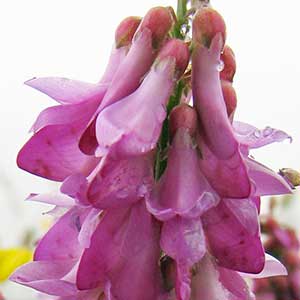Hedysarum occidentale
Hedysarum boreale
western hedysarum, western sweet-vetch
boreal sweetvetch, northern hedysarum, northern sweet-vetch, plains sweetbroom, Utah sweetvetch
decumbent to erect, (1.2–)2–9.5 dm.
decumbent to erect, usually much branched, 1.5–7 dm.
3.5–23 cm;
stipules 10–17 mm;
leaflets 9–19, blades lanceolate to ovate, elliptic, or oblong, 5–40 × 3–16 mm, veins conspicuous, surfaces usually pubescent, rarely glabrous adaxially.
3–12(–14) cm;
stipules pale brown, sometimes streaked, 2–10 mm;
leaflets 5–15, blades usually oblong to elliptic, lanceolate-oblong, or ovate, rarely linear, 7–40 × 2–19 mm, veins obscure, surfaces strigose abaxially, strigose or glabrous adaxially.
10–50-flowered, axis 4–25 cm in fruit;
bracts 1–4 mm.
5–45-flowered, axis 5–28.5 cm in fruit;
bracts 2–4 mm.
(3–)6–15 cm.
2.8–15 cm.
1–3.5 mm.
0.8–4.5 mm.
usually declined at anthesis;
calyx 3.5–11 mm;
tube 3–9 mm, puberulent;
lobes subulate to triangular, 0.5–2 mm, equal or nearly so;
corolla usually lavender-pink or lilac- to pink-purple, rarely white, 16–25 mm;
wing auricles connate, linear, nearly equal or equal to claw.
ascending at anthesis;
calyx 4.5–8 mm;
tube 2–3.5 mm, strigose;
lobes subulate, 2–6 mm, subequal to markedly unequal;
corolla usually red-purple, pink, magenta, or purple, rarely white, 10–22(–26) mm;
wing auricles distinct, blunt, shorter than claw.
segments (1 or)2–5, 7–14.5(–18) × 5.6–10.2(–11) mm, margins conspicuously winged, prominently reticulate, pubescent or glabrous.
segments 2–8, 4.5–9 × 4–6.2 mm, margins prickly or not, not winged to moderately winged, prominently reticulate, usually crisp-puberulent to minutely strigose, rarely glabrous.
Hedysarum occidentale
Hedysarum boreale
Varieties 2 (2 in the flora).
(Discussion copyrighted by Flora of North America; reprinted with permission.)
Subspecies 2 (2 in the flora).
(Discussion copyrighted by Flora of North America; reprinted with permission.)
1. Leaflet blades usually 2–4 times longer than wide, not or rarely thickened, not especially deciduous; flowers 16–22 mm, usually lilac- to pink-purple, rarely white; widespread. | var. occidentale |
1. Leaflet blades mostly 1–2 times longer than wide, becoming thickened, early deciduous; flowers (17–)20–25 mm, pale lavender-pink; w Colorado, e Utah. | var. canone |
1. Flowers 10–19 mm, usually pink to magenta or purple, rarely white; racemes 8–23 cm; loment segments 2–5. | subsp. boreale |
1. Flowers (14–)18–22(–26) mm, usually red-purple, sometimes pink, rarely white; racemes 2–10(–15) cm; loment segments 3–8. | subsp. mackenziei |


